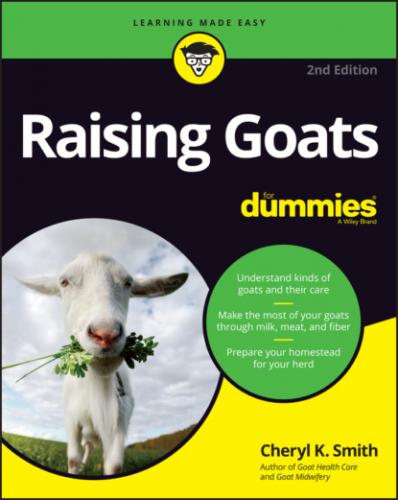Raising Goats For Dummies. Cheryl K. Smith
and have long ears that stick out sideways. They often have long horns that curve backward. They can be shy animals (wouldn’t you be if you kept falling down at the most inopportune times?) but have sweet personalities.
These goats can be registered by either the Myotonic Goat Registry (MGR) or the International Fainting Goat Association (IFGA). These goats are currently listed as “recovering” on the Livestock Conservancy’s list of rare livestock breeds.
Some people buy fainting goats for the novelty of scaring them and watching them drop. The goats have allegedly served another purpose — protecting sheep when a predator comes around. The goat drops and the predator eats the goat instead of the sheep. That’s literally a sacrificial goat!
Kiko goats
The Kiko goat is a newer breed that was created in New Zealand purely as a meat goat. Kikos are most often white with long, scimitar-like horns and medium ears that stick out sideways. They can gain substantial weight without supplemental feeding, which is a big plus for producers. If you have substantial range for these goats, they may be even more economical than Boers.
Kikos came into the United States in the 1990s and were found to be superior to the Boer goat in terms of hardiness and adaptability. Their hooves have to be trimmed less frequently than other goats, they kid easily, and the does are good mothers. These traits make them perfect for a life on the range.
Kiko goats and offspring from crosses with other meat goats can be registered with the International Kiko Goat Association. They officially recognize a Boer/Kiko cross called the American Meatmaker. The American Kiko Goat Association (AKGA) allows some crossbreed registration, but the sire must always be a purebred Kiko.
Spanish goats
If you decide to get a Spanish goat, you will also be getting a little bit of U.S. history. These goats were originally brought over from Spain in the 16th century and evolved into nearly indigenous goats in the southern United States. Because they were feral, they are much hardier than goats such as the Boer so they make good, easy-care meat goats, much like the Kiko.
The American Livestock Breeds Conservancy has developed standards for the Spanish goat and formed the Spanish Goat Association (SGA). Its goal is to find Spanish goats and breeders in the United States to preserve the gene pool. The number of breeders is limited, and so far none operate in the West or Northeast.
FIGURE 3-7: A long-haired Spanish goat, also considered Cashmere.
www.spanishgoats.org.
Texmaster goats
The Texmaster is a moderate-sized meat goat and a trademarked cross between Boers and Tennessee meat goats (myotonics) developed by Onion Creek Ranch in Texas. They usually don’t “faint,” but they do add to the meatiness of the breed.
Moneymaker meat goats
Moneymaker meat goats were developed by Bob and Dusty Copeland of California by first crossbreeding Saanens and Nubians and then adding Boers into the mix. This crossbreed has the advantage of easy kidding, often with triplets. In addition, the does are able to put the desired weight on kids within four or five months of nursing. The breeders have found that the ideal mix is 75 percent Boer and 25 percent Saanen/Nubian cross.
Savanna goats
Another South African meat breed brought to the United States is the Savanna. These goats are known for their heat and drought resistance and excellent mothering abilities. Savannas are a muscular breed with long ears, thick black skin, and a short white coat that develops a nice, fluffy cashmere undercoat for additional warmth during the winter. They are highly adaptable to a variety of unpleasant weather conditions, having done well in both Canada and the southeastern United States.
Because international law now prohibits bringing in any new genetic material, these goats are expensive and harder to come by.
Investigating Fiber Goats
If you are a home spinner or want to get your own supply of fiber, consider the fiber goats. Angoras produce the fiber called mohair, which is a silky fiber used in many products. Cashmere, produced by the cashmere goat, is an even more exotic fiber and is in high demand. It comes from the undercoat of these goats.
Fiber goats, if you properly care for them, take a bit more work than some of the other goats. You can choose from medium to small goats in a variety of colors. If you want meat, some of these are dual-purpose goats.
A number of registries exist for fiber goats, mostly depending on the breed, but in two cases specifically for colored fiber goats. These include the American Angora Goat Breeders Association (AAGBA), the Cashmere Goat Association (CGA), the Pygora Breeders Association (PBA), the PCA Goat Registry, and the Colored Angora Goat Breeders Association (CAGBA).
While CAGBA is only for Angoras, the PCA Goat Registry is hybrid-based, registering goats whose parents are already registered by CAGBA, PBA, NPGA, and AAGBA.
In the upcoming sections, I tell you about the choices you have in fiber goats and some of the pros and cons of each.
Angora
Angoras have long, wavy coats, with fiber called mohair. (Angora fiber comes from rabbits.) They are usually white, but some breeders are experimenting with producing other colors. Their horns can be long or short and are curved or spiral, in the case of bucks. They are usually left on the goat, because they may regulate body temperature. The average adult goat produces 8 to 16 pounds of mohair each year, while kids give from 3 to 5 pounds of longer, finer hair. Figure 3-8 shows an Angora buck.
FIGURE 3-8: An Angora buck.
Angora
